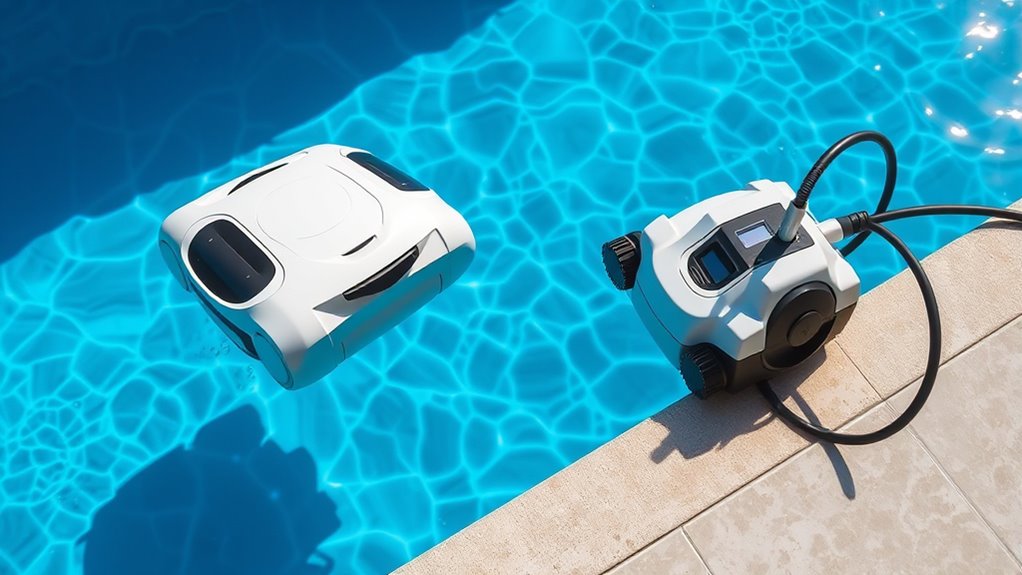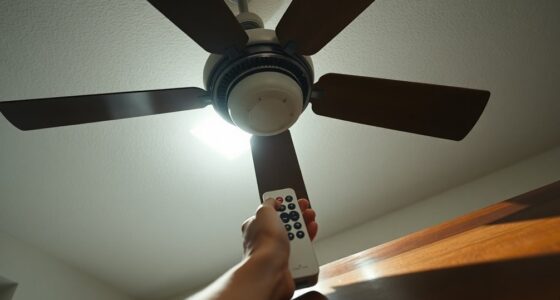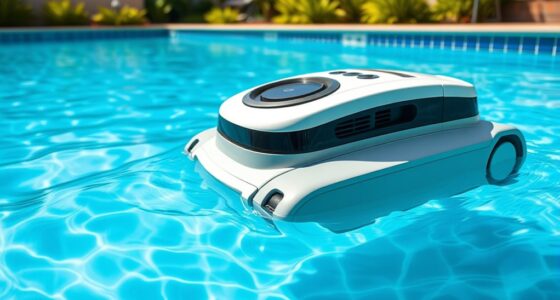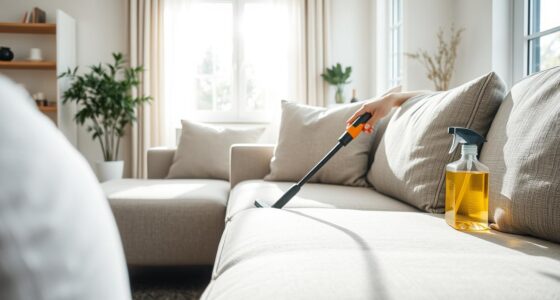When choosing between pressure and robotic pool cleaners, consider your pool size, shape, and budget. Pressure cleaners are easier to set up and work well for big debris but may use more energy and offer less coverage. Robotic cleaners cost more upfront but are more efficient, energy-saving, and provide thorough cleaning with advanced features. If you want a smart, low-maintenance option, a robotic cleaner might be best—discover more about each type’s full benefits below.
Key Takeaways
- Robotic cleaners offer advanced navigation, thorough cleaning, and customizable modes, while pressure cleaners rely on water pressure and simpler operation.
- Robotic models typically have higher upfront costs but lower long-term maintenance and energy expenses compared to pressure cleaners.
- Pressure cleaners are easier to set up and operate but may struggle with detailed cleaning and obstacle navigation.
- Robotic cleaners provide superior debris removal, better coverage, and adaptability to various pool shapes and finishes.
- Robotic options are more energy-efficient, environmentally friendly, and feature modern smart technology integration.
Design and Operating Mechanism

Pressure and robotic pool cleaners differ substantially in their design and operating mechanisms. Pressure cleaners utilize design innovation by attaching to your pool’s existing filtration system, using water pressure to power their movement. Their operating mechanics depend on the flow of water; as pressure builds, the cleaner moves along the pool floor, walls, and steps. Robotic cleaners, on the other hand, feature dedicated motors and advanced navigation systems, allowing for precise and independent operation. Their design emphasizes versatility and maneuverability, often including brushes and scrubbing components. The operating mechanics in robotic models involve sensors and programmed paths, enabling them to cover the entire pool efficiently. Additionally, robotic cleaners often incorporate smart technology for enhanced control and scheduling, making maintenance more convenient. Incorporating industry trends can help you select the most effective cleaning solution for your pool needs. Furthermore, advancements in cleaning efficiency continue to improve the performance and energy consumption of both types of cleaners. As technology progresses, the integration of energy-efficient components enhances overall operation and reduces power consumption. Exploring consumer preferences can also guide your decision-making process to find the best fit for your specific requirements.
Cost and Budget Considerations
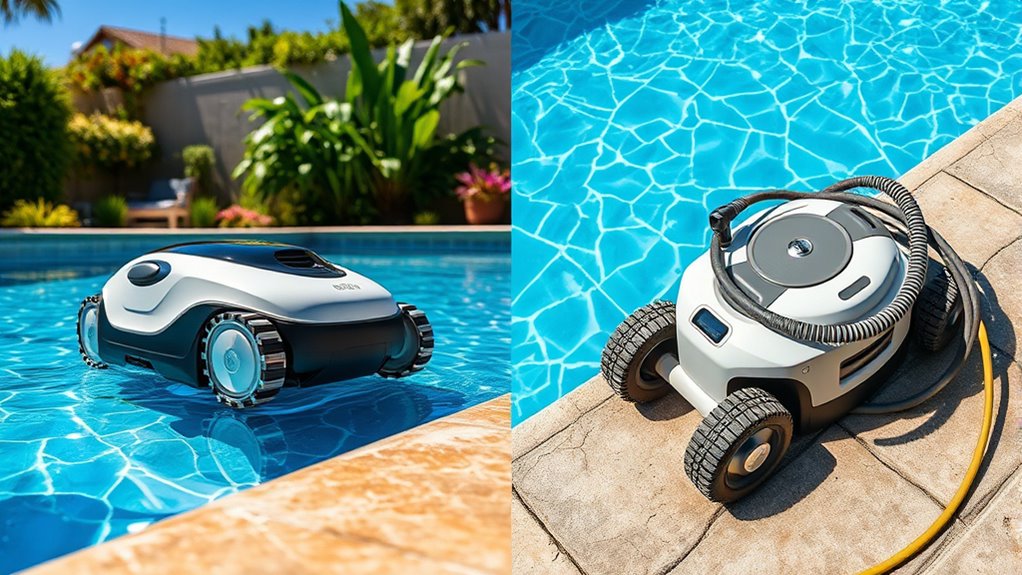
When choosing between pressure and robotic pool cleaners, cost is a significant factor that influences your decision. Your budget planning should consider both upfront costs and long-term expenses. Here are four key points to keep in mind:
Cost considerations, including initial investment and maintenance, are key when choosing pool cleaners.
- Initial investment varies widely, with robotic cleaners generally costing more upfront. Cost comparison can help determine which cleaner fits your financial plan best. Additionally, the initial setup process for robotic cleaners may require more time and effort compared to pressure models. Considering the ease of use can also impact your overall satisfaction with the purchase.
- Robotic models often offer better cost efficiency over time due to lower energy consumption, especially with advanced energy efficiency features integrated into modern designs.
- Maintenance costs, including parts and repairs, can impact your overall budget. Regular upkeep may also extend the lifespan of your pool cleaner.
- Durability and warranty coverage influence long-term savings and peace of mind. Choosing a model with a comprehensive warranty can reduce unexpected repair expenses.
- The contrast ratio of a pool cleaner’s filtration system can also affect its cleaning efficiency and operational costs.
Ease of Use and Setup
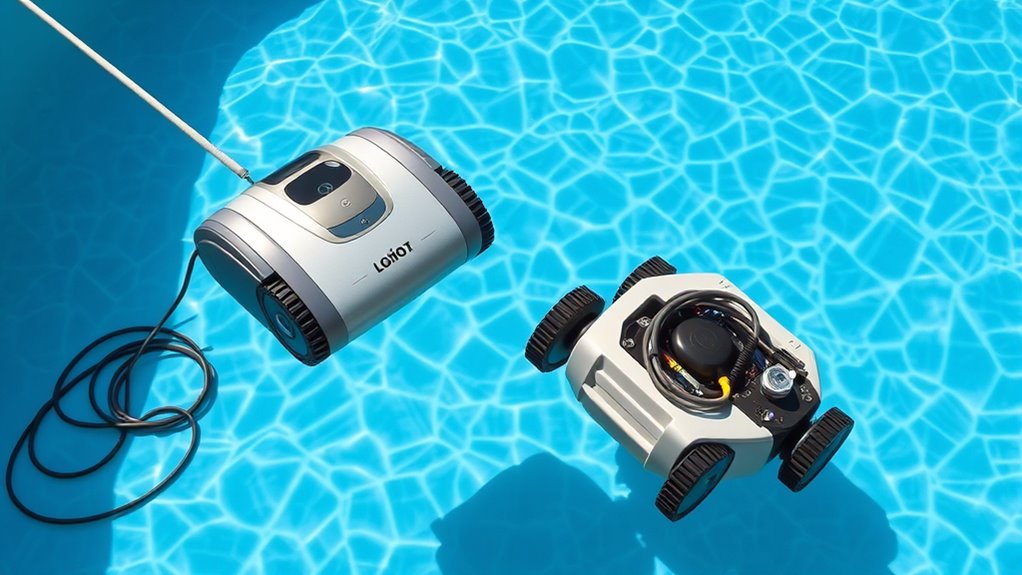
Robotic pool cleaners are designed to be user-friendly, often requiring minimal setup and maintenance. You can typically get them up and running quickly, with simple instructions that eliminate the need for manual operation. Unlike pressure cleaners, which may involve more installation complexity, robotic models usually come with straightforward setup steps, such as plugging in the power supply and placing the robot in the pool. Many feature automatic operation modes, reducing your involvement during cleaning. This ease of use means you spend less time on installation and more time enjoying your pool. Additionally, robotic cleaners often include advanced features that enhance their efficiency and convenience, making them the ideal choice for a hassle-free experience, with minimal effort needed to start cleaning and maintain the device. Proper tuning software can also optimize the cleaning cycles for better performance and energy efficiency, and some models are compatible with smart home integrations for even more seamless operation. Moreover, their compact design allows for easier storage and handling after use. Incorporating efficient general ledger coding practices can also streamline maintenance records and operational data management, further simplifying upkeep.
Cleaning Performance and Efficiency
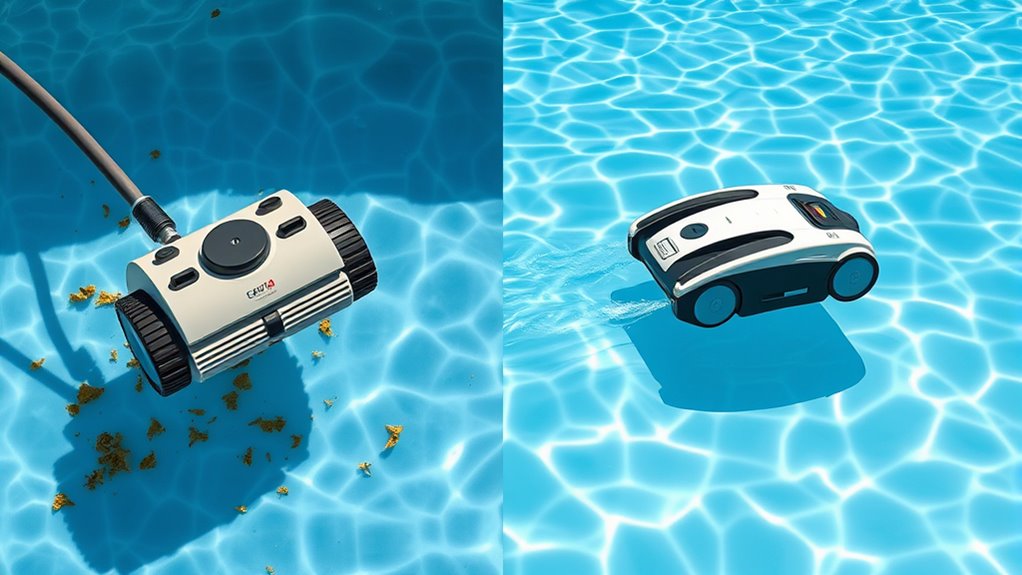
You’ll notice differences in cleaning power and how thoroughly each type covers your pool, impacting overall efficiency. Energy consumption rates also vary, affecting your long-term costs and sustainability. Understanding their coverage and mobility helps you choose a cleaner that works best for your pool’s shape and size. Additionally, selecting a model with efficient energy usage can help reduce operational expenses over time. Proper maintenance and understanding the suction and pressure mechanisms can further enhance performance and longevity of your pool cleaner. For example, tuning in vehicles demonstrates how adjustments can optimize performance, similar to how selecting the right cleaning technology can improve pool maintenance. Being aware of regional availability can ensure you select a model that is easily accessible in your area, minimizing delays and additional costs. Considering performance upgrades can also lead to better cleaning results and durability of your pool cleaner over its lifespan.
Cleaning Power Differences
Pressure pool cleaners typically excel at quickly removing large debris and covering wide surface areas, thanks to their powerful jets and strong suction. However, their cleaning effectiveness can vary based on debris type and pool layout. To understand the cleaning power differences:
- Robotic cleaners often deliver superior debris removal, especially smaller particles, due to their precise brushes and filters.
- Pressure cleaners tend to rely on water flow, which might miss finer debris or get tangled in intricate pool features. Incorporating advanced navigation features can improve their coverage and reduce manual intervention. Additionally, robotic models often have better adaptability to different pool shapes due to programmable movement patterns.
- Robotic models usually have programmed movement patterns, enhancing overall cleaning coverage and efficiency.
- Pressure cleaners are generally faster at big surface areas but may require more manual intervention for detailed cleaning tasks.
- Some robotic pool cleaners incorporate advanced tuning features that optimize their cleaning cycles for different debris types and pool shapes. Using sensor technology can further enhance their ability to detect debris and navigate complex pool environments.
Ultimately, your choice impacts cleaning effectiveness, especially for stubborn or fine debris.
Energy Consumption Rates
While pressure pool cleaners are known for their rapid coverage of large surface areas, they often consume more water and energy to operate at full capacity. These cleaners typically rely on your pool’s pump, increasing energy use, especially if run frequently. Using solar power can help offset some energy costs, making them more eco-friendly, but overall, they tend to have higher consumption rates. Manual operation can reduce power use since you control when the cleaner runs, but it may compromise efficiency. Robotic cleaners generally consume less energy because they operate independently of your pool’s filtration system. If saving energy is a priority, robotic models with low power consumption are a better option, whereas pressure cleaners may lead to higher operational costs over time. Additionally, energy-efficient designs in newer models can help reduce overall electricity consumption while maintaining cleaning performance. Furthermore, selecting models with advanced technology can enhance energy savings and optimize cleaning cycles, especially when paired with smart controls that adjust operation times for maximum efficiency.
Coverage and Mobility
Robotic pool cleaners excel in providing thorough coverage and efficient mobility, often outpacing pressure cleaners in cleaning performance. They navigate pools more systematically, reducing coverage limitations and overcoming mobility challenges. Here’s why they stand out:
- Advanced algorithms allow for exhaustive pool coverage, minimizing missed spots.
- Precise maneuvering helps avoid coverage limitations caused by obstacles or complex shapes.
- Strong wheels and tracks tackle mobility challenges on various surfaces.
- Smart mapping ensures efficient cleaning paths, saving time and energy.
While pressure cleaners rely on water flow, robotic models adapt to pool layouts, providing consistent performance. Their ability to handle coverage and mobility issues makes them superior in delivering a cleaner, more sparkling pool.
Maintenance and Durability
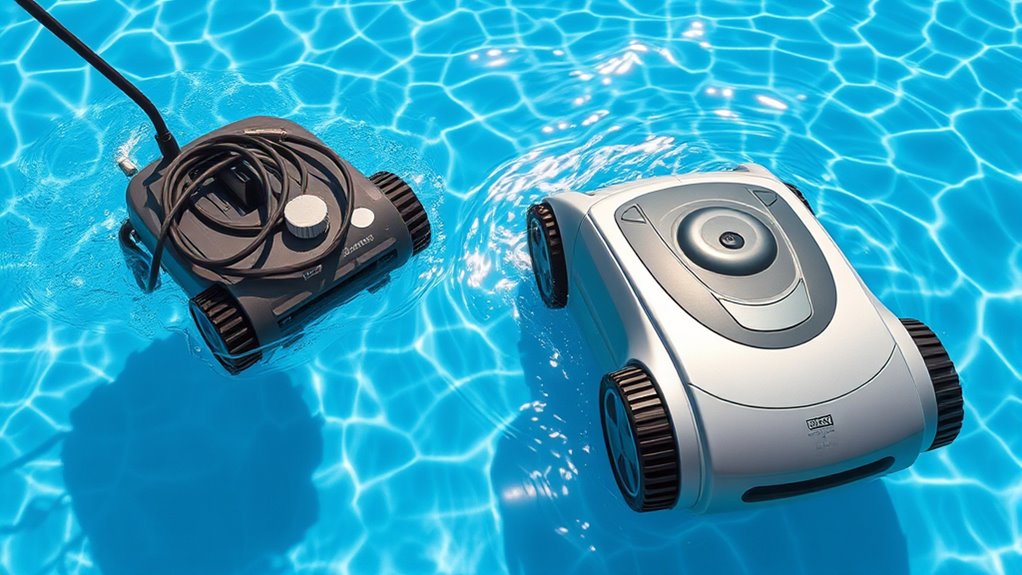
Maintenance and durability are essential factors to consider when choosing between pressure and robotic pool cleaners. You want a cleaner that withstands regular use and harsh pool conditions, so durability matters. Robotic cleaners are often built with corrosion-resistant materials, ensuring they hold up against chlorine exposure and pool chemicals. They typically require less maintenance because their components are designed for longevity and resistance to corrosion. Pressure side cleaners, on the other hand, may need more frequent repairs or replacements due to wear from constant water pressure and exposure to chemicals. Both types can be durable if properly maintained, but robotic cleaners generally offer better chlorine resistance and corrosion resistance, making them a more reliable choice for long-term use.
Energy Consumption and Environmental Impact
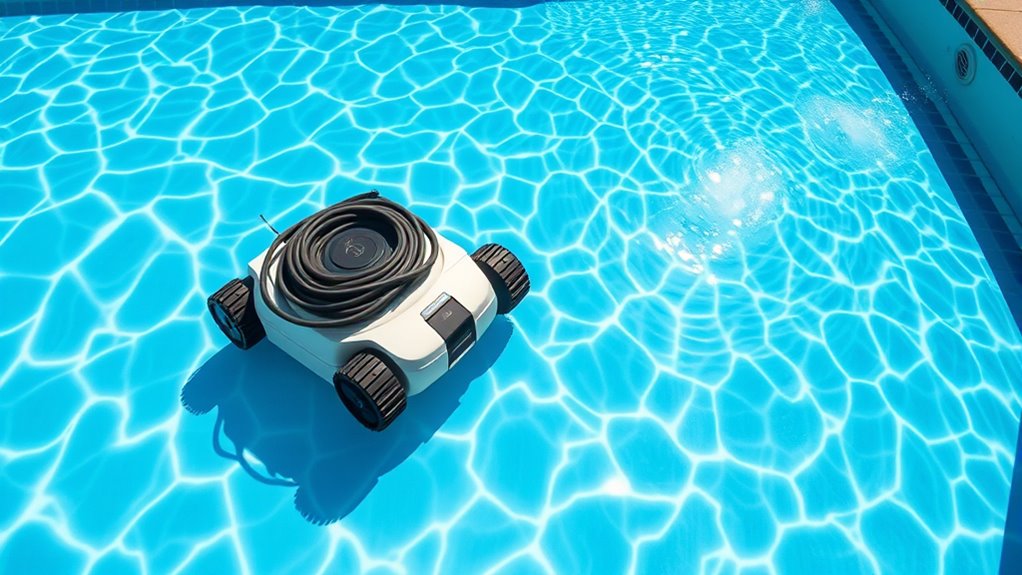
When comparing pressure and robotic pool cleaners, energy consumption plays a significant role in their overall environmental impact. Robotic cleaners often use less energy, especially if they incorporate solar power options, reducing reliance on traditional electricity. They tend to be more efficient, leading to waste reduction by minimizing unnecessary power use. To understand their environmental footprint better:
- Robotic cleaners with solar panels cut energy costs and carbon emissions.
- Pressure cleaners often consume more electricity, increasing environmental impact.
- Reduced waste results from efficient cleaning cycles.
- Choosing energy-efficient models supports eco-friendly pool maintenance.
Your choice influences not only your energy bills but also the planet’s health, making it essential to weigh energy consumption and waste reduction when selecting a pool cleaner.
Versatility and Pool Compatibility
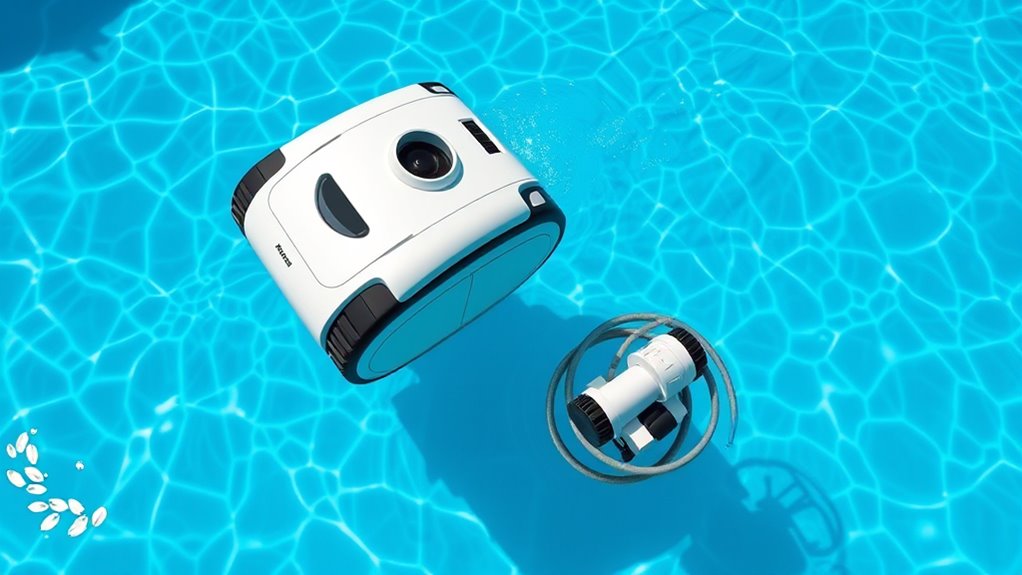
While both pressure and robotic pool cleaners are designed to keep your pool tidy, their versatility and compatibility with different pool types vary considerably. Pressure cleaners work well with in-ground pools and can handle various surface types, but they often have specific chemical compatibility needs that might limit their use with certain chemicals. Robotic cleaners are more adaptable, compatible with a wider range of pool finishes, and generally require less maintenance related to chemical exposure. However, their storage requirements can differ; robotic models often need dedicated space and protective cases, especially if they contain sensitive electronic parts. Overall, robotic cleaners tend to offer greater versatility, while pressure cleaners may need more attention to chemical compatibility and storage considerations.
Technological Features and Smart Capabilities
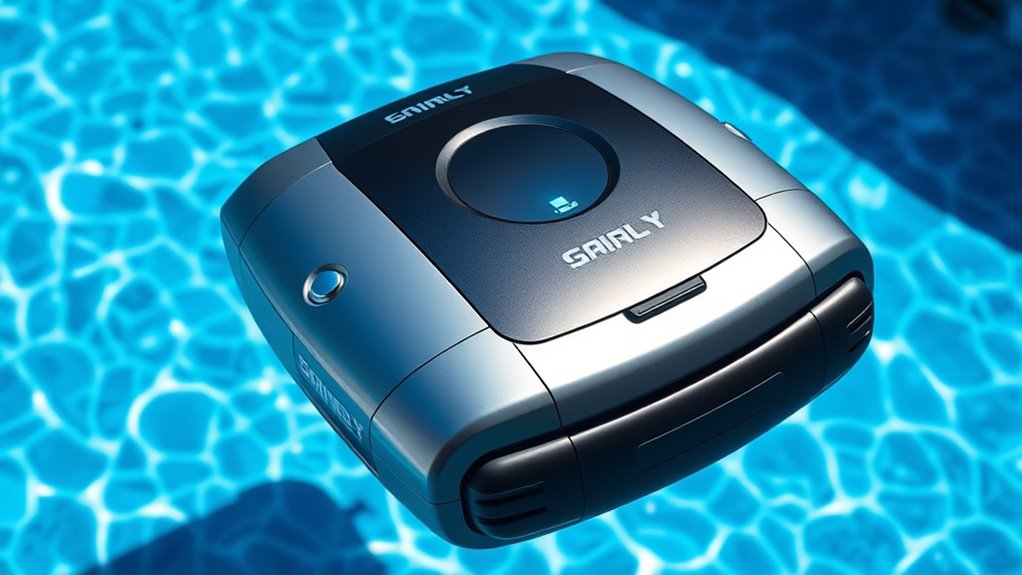
Technological advancements have considerably enhanced the capabilities of both pressure and robotic pool cleaners, making them more efficient and user-friendly. Modern models now feature AI integration, allowing them to adapt to your pool’s layout and cleaning needs intelligently. The user interface has also improved, often offering intuitive controls via smartphone apps for seamless operation. Here are some key features to consider:
Modern pool cleaners utilize AI and intuitive controls to deliver efficient, smart, and effortless cleaning experiences.
- AI-driven navigation ensures thorough cleaning without missing spots.
- Touchscreen controls simplify setup and scheduling.
- Real-time status updates keep you informed on cleaning progress.
- Customizable cleaning modes tailored to your pool’s specific requirements.
These smart capabilities not only save you time but also optimize cleaning performance, making your pool maintenance more effortless and effective.
Long-term Investment and Value
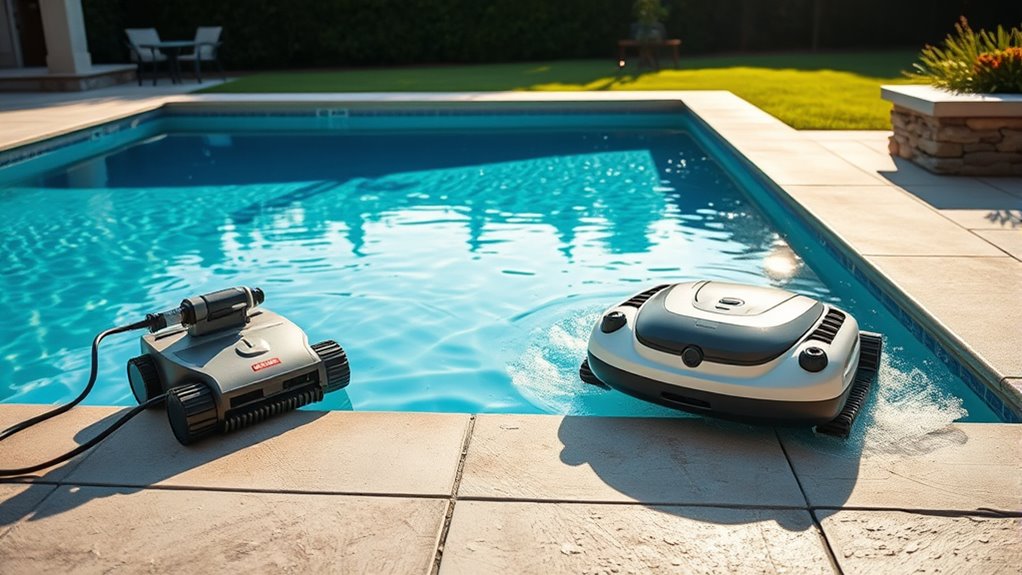
Investing in a pool cleaner is a decision that pays off over time, especially when considering the long-term value it provides. A robotic cleaner often has higher upfront costs but can reduce ongoing maintenance expenses by efficiently cleaning your pool, minimizing the need for professional services. Its durability and advanced features can lower future maintenance costs, saving you money over the years. Additionally, a well-maintained pool with a reliable cleaner can boost your home’s resale value, making your investment even more worthwhile. Pressure cleaners may have lower initial prices, but their higher operational costs and less exhaustive cleaning can add up over time. Ultimately, choosing a robotic pool cleaner can be a smart, long-term investment that enhances your pool’s condition and your property’s value.
Frequently Asked Questions
Which Type Is Better for Above-Ground Pools?
When choosing the best cleaner for your above-ground pool, consider your pool size and cleaning speed. Smaller pools may only need a quick, efficient cleaner, while larger pools require a device that can cover more area faster. Robotic cleaners often excel in cleaning speed and thoroughness, especially for above-ground pools, making them a convenient choice. Pressure cleaners can work well too, but robotic options typically offer more consistent and all-encompassing cleaning.
How Does Water Chemistry Affect Pressure and Robotic Cleaners?
You might think water chemistry doesn’t impact pool cleaners, but it actually does. Water mineralization and pH imbalance can clog robotic cleaners’ filters or hinder their movement, reducing efficiency. For pressure cleaners, mineral buildup can affect water flow, making cleaning less effective. Maintaining balanced water chemistry guarantees your pressure and robotic cleaners work smoothly, prolonging their lifespan and keeping your pool sparkling. Properly balanced water makes all cleaning methods more reliable and effective.
Can These Cleaners Handle Algae and Stubborn Debris?
You might wonder if these cleaners can handle algae removal and debris clearance effectively. Many robotic models are designed with specialized brushes and filters that tackle stubborn algae and debris, making cleanup easier. They can navigate tight corners and scrub surfaces thoroughly. While pressure cleaners excel at surface debris, robotic cleaners often provide more extensive algae removal, ensuring your pool stays cleaner and clearer with less manual effort on your part.
Are There Safety Concerns With Robotic and Pressure Cleaners?
You might wonder if safety features, electrical hazards, and proper use make pool cleaners safe. Both robotic and pressure cleaners come with safety features like automatic shut-off and insulated cords to prevent electrical hazards. To stay safe, always follow manufacturer instructions, inspect cords regularly, and guarantee proper grounding. With careful use, you minimize risks and enjoy clean pools without worry. Safety is a priority with both types of cleaners when used correctly.
How Do Warranty and Customer Support Compare Between Types?
When comparing warranties and customer support, you’ll find that robotic pool cleaners often offer longer warranties and more extensive coverage. Manufacturers typically provide better customer support quality for robotic models, with quicker responses and detailed guidance. Pressure cleaners may have shorter warranties and less personalized support. Overall, robotic cleaners tend to give you a more reliable warranty comparison and superior customer service, making them a better choice for peace of mind.
Conclusion
So, whether you choose a pressure or robotic pool cleaner, remember it’s really about your *battle* with the algae and dirt, not just the price tag. Sure, one’s cheaper and the other’s smarter, but at the end of the day, you’re still the one sweating in the sun, pretending it’s fun. Pick your fighter wisely—because nothing says “luxury” like spending more time cleaning than actually swimming. Happy pool cleaning, champion of the backyard!
